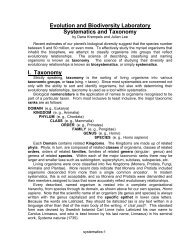Pollination Biology and the Impact of Floral Offer, Pollen Donor ...
Pollination Biology and the Impact of Floral Offer, Pollen Donor ...
Pollination Biology and the Impact of Floral Offer, Pollen Donor ...
You also want an ePaper? Increase the reach of your titles
YUMPU automatically turns print PDFs into web optimized ePapers that Google loves.
In <strong>the</strong> experiments <strong>of</strong> self, cross <strong>and</strong> intra–morph h<strong>and</strong> pollination, only inter–<br />
morph crosses set fruit (Table 2). For <strong>the</strong>se inter-morph crosses, 25 percent <strong>of</strong> pin flowers<br />
<strong>and</strong> 30 percent <strong>of</strong> thrum flowers aborted (Table 2).<br />
TABLE 2. Results from self <strong>and</strong> cross artificial pollinations in Arcytophyllum lavarum<br />
(n = no. <strong>of</strong> flowers, Number <strong>of</strong> patches = 11)<br />
Cross<br />
n<br />
Percent <strong>of</strong> flowers<br />
that set fruit<br />
Pin X Pin 17 0<br />
Pin X Thrum 24 75<br />
Pin X Self pollination 22 0<br />
Thrum X Pin 17 70<br />
Thrum X Thrum 14 0<br />
Thrum X Self pollination 16 0<br />
There was no difference between floral morphs in <strong>the</strong> number <strong>of</strong> seeds produced<br />
by h<strong>and</strong>-pollinated flowers (Mean ± SD pin = 4.5 ± 3.8, Mean ± SD thrum = 2.9 ± 2.9, t =<br />
1.3, df = 33, , P = 0.2, N pin s = 22, N thrum s = 13). Breeding system results show that A.<br />
lavarum displays a self <strong>and</strong> morph-incompatible breeding system.<br />
FLOWER VISITORS.––– Flowers <strong>of</strong> A. lavarum were visited by small Diptera (1-5 mm)<br />
from <strong>the</strong> families Chironomidae, Scatopsidae <strong>and</strong> Sciaridae. O<strong>the</strong>r small flower visitors<br />
include chrysomelid <strong>and</strong> curculionid beetles, aphids <strong>and</strong> thrips. These flower visitors stay<br />
inside <strong>the</strong> corolla feeding on pollen or nectar, walking or flying to nearby flowers.<br />
chrysomelid beetles were observed feeding on pollen from an<strong>the</strong>rs. Larvae <strong>of</strong><br />
Geometridae feed on pollen <strong>and</strong> are also are pre–dispersal seed predators. The behavior<br />
<strong>of</strong> <strong>the</strong>se flower visitors suggests that <strong>the</strong>y might not play a major role in <strong>the</strong> pollen<br />
-13-

















